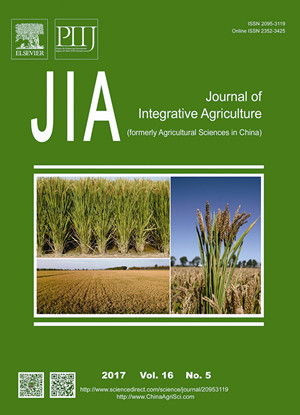|
|
Peach yield and fruit quality is maintained under mild deficit irrigation in semi-arid China
ZHOU Han-mi, ZHANG Fu-cang, Roger Kjelgren, WU Li-feng, GONG Dao-zhi, ZHAO Na, YIN Dong-xue, XIANG You-zhen, LI Zhi-jun
2017, 16(05):
1173-1183.
DOI: 10.1016/S2095-3119(16)61571-X
We conducted a two-year study of deficit irrigation impact on peach yield and quality in semi-arid northwest China. Over two years, four-year-old peach trees were irrigated at 100, 75, 50 and 25% of peach evapotranspiration (ETc), here, ETc= Coefficient (Kc)×Local reference evapotranspiration (ETo). During the April-July fruit production season we measured root zone soil water depletion, sap flow velocity, net photosynthetic rate (Pn), transpiration rate (Tr), stomatal conductance (Gs), water use efficiency (WUE=Pn/Tr), fruit quality, and yield under a mobile rain-out shelter. Increased soil water depletion reasonably mirrored decreasing irrigation rates both years, causing progressively greater water stress. Progressive water stress lowered Gs, which in turn translated into lower Tr as measured by sap flow. However, mild deficit irrigation (75% ETc) constricted Tr more than Pn. Pn was not different between 100 and 75% ETc treatments in both years, and it decreased only 5–8% in June with higher temperature than that in May with cooler temperature. Concurrently under 75% ETc treatment, Tr was reduced, and WUE was up to 13% higher than that under 100% ETc treatment. While total fruit yield was not different under the two treatments, because 75% ETc treatment had fewer but larger fruit than 100% ETc trees, suggesting mild water stress thinned fruit load. By contrast, sharply decreased Tr and Pn of the driest treatments (50 and 25% ETc) increased WUE, but less carbon uptake impacted total fruit yield, resulting 13 and 33% lower yield compared to that of 100% ETc treatment. Irrigation rates affected fruit quality, particularly between the 100 and 75% ETc trees. Fewer but larger fruit in the mildly water stressed trees (75% ETc) resulted in more soluble solids and vitamin C, firmer fruit, and improved sugar:acid ratio and fruit color compared to the 100% ETc treatment. Overall, trees deficit irrigated at 75% ETc maintained yield while improving fruit quality and using less water.
|
